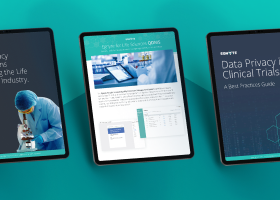Pharmacokinetics
Pharmacokinetics is the branch of pharmacology focused on how drugs navigate through the body — specifically, what the body does to the drug. Understanding this makes it possible to quantify how the dose is administered, the regimen for dosing, and the resulting concentration of the drug in the body. This information facilitates a balance between maximum efficacy and minimal toxicity.

The way that the body reacts to and affects a drug depends on its pharmacological properties, which include:
- Rate and extent of uptake of the drug from its site of administration
- Rate and extent of distribution of the drug to different tissues, including the site of action
- Rate of elimination of the drug from the body
The word pharmacokinetics is derived from the Greek words pharmakon, drug, and kinetikos, movement.
Ancient Greek Roots of Pharmacokinetics
Pharmacokinetics is used to describe the dynamic movements of drugs as they progress through the body and the kinetics of absorption, distribution, metabolism, and excretion of the drug.
Drug Absorption
Drugs can enter the body via several sites—orally, intravenously, or topically through mucous membranes. The route of administration affects absorption and the ability of a drug to reach and accumulate in the desired location. How drugs are absorbed into the circulation depends on the formulation—solid, polymer, semisolid, or liquid.
Drug Distribution
Drugs are most commonly absorbed into the bloodstream. Once in circulation, the drug is transferred to the target organs and muscles. Bioavailability describes the rate at which an absorbed drug enters circulation.
Drug Metabolism or Biotransformation
Depending on the type of drug, it will need to be converted into a less or more active form or metabolite. In most cases, active drugs are turned into an inactive metabolite that is ready to be excreted.
Other drugs are inactive and need to be metabolized into an active metabolite to produce the desired effect. The active metabolite is then further metabolized to be inactivated and excreted.
Drug Excretion
The primary sites for drug excretion are the liver and kidney. Other excretion sites include the skin, lungs, and bile, and intestine. If excretion is incomplete, the drug can accumulate and have adverse effects.
How Drug Formulations Influence Pharmacokinetics
The formulation of a drug can significantly influence its pharmacokinetics. For a drug to be effective, it has to dissolve so it can be absorbed and distributed. Depending on the desired pharmacokinetics, different formulations will be used for each drug. Following are examples of drug formulation options and their delivery routes.
Solid Formulations
Drugs with solid formulations, such as tablets, capsules, and suppositories, must disintegrate to release the drug. Some solid formulations are designed so that the drugs only disintegrate in certain sections of the gastrointestinal (GI) tract.
For instance, enteric-coated tablets only disintegrate in the small intestine to protect the drug from destruction by gastric acid of the stomach or to protect the stomach from an irritant drug, such as aspirin. Solid formulations are also used for drugs that require controlled-release, extended-release, or sustained-release to prolong their duration of action.
Polymer Formulations
Another category of solid formulations is polymer formulations that gradually release the drug or release it at specific locations. Examples of polymer formulations include transdermal patches and drug-eluting stents. Other polymer-based formulations can be delivered intravenously.
Semisolid Formulations
Semisolid formulations include ointments, creams, gels or jellies, pastes, rigid foams, and emulsions. The drug is released when applied topically with external application to the skin or mucous membranes, such as the eyes, nose, vagina, and rectum.
Liquid Formulations
Disintegration is not required for liquid formulations, which makes them more readily absorbable. Liquid formulations may be administered intravenously or taken orally. This formulation makes it easier to consume for people who have issues with swallowing tablets or capsules.
Pharmacokinetics and Drug Transfer
For a drug to transfer to its site of action, it must be absorbed and distributed. Pharmacokinetic mechanisms allow a drug to traverse numerous biological membranes. Some of the pharmacokinetic processes that make this possible include:
- Passive diffusion
- Active transport
- Facilitated transport
- Filtration
- Endocytosis
Pharmacokinetics Differences in Men and Women
Drug Absorption
The gastrointestinal (GI) transit rate can affect the pharmacokinetics of drugs taken orally. Since women have slower GI transit than men, they may need to wait longer between food consumption and administration if a drug is meant to be taken on an empty stomach.
Drug Distribution
Pharmacokinetics are also impacted by the fat and water differences in women and men. Women have a higher percentage of body fat but lower body water content compared to men. This can affect the volume of distribution of certain drugs.
Because some drugs accumulate in body fat, they can stay in women’s bodies longer. For drugs with chronic dosage, this can lead to a build-up in women’s systems that could have adverse effects. On the other hand, the volume of distribution for water-soluble drugs is lower in women, which results in a higher initial plasma concentration.
Drug Excretion
Men have a higher renal blood flow rate than women. The pharmacokinetic impact of this is that women have a slower clearance rate for drugs that are eliminated in the kidneys.
Other Factors
- Differences in body weight and percentage of body fat, organ size and output, plasma volume, and regional blood flow between men and women
- How well blood is filtered by kidneys (i.e., glomerular filtration rate) and different rates of food movement through the GI system (i.e., gastric motility) in women compared with men
- Pregnancy increases plasma volume and total body water, prolongs gastric emptying, changes metabolism, and impacts excretion
Pharmacokinetics Issues Related to Aging
Drug Absorption
Older patients often have difficulty swallowing, which creates a challenge for medications in capsule or tablet form. It is common for patients with this issue to crush tablets or open capsules.
While this solves the swallowing problem, it alters the absorption characteristics of the medication. This may result in changes in the drug pharmacokinetics and result in overdose or other adverse effects.
Drug Distribution
As people age, changes in their body composition can affect pharmacokinetics. Drug distribution is impacted by the increase in body fat percentage, a decrease in lean muscle mass associated with aging, and a reduction in overall body water. Since pharmacokinetics depends on body composition, these changes can affect dosage or dosing.
Drug Metabolism
Most metabolism takes place in the liver, which changes as people age. A reduction in total liver size can reduce blood flow significantly, decreasing the levels of drug-metabolizing enzymes.
Drug Excretion
The total size of the kidneys decreases with age, as does their function and blood flow. This impacts pharmacokinetics by reducing drug clearance in older patients.
Pharmacokinetics for Quantitative Pharmacology
Pharmacokinetics plays a vital role in pharmacology. It provides quantitative direction for drug formulation.
The nuances of pharmacokinetics key mechanisms — drug absorption, distribution, metabolism, and elimination — strongly influence the success or failure of treatment. These fundamental pharmacokinetic principles to pharmacology enable safer and more effective drugs and patient outcomes.
Egnyte has experts ready to answer your questions. For more than a decade, Egnyte has helped more than 16,000 customers with millions of customers worldwide.
Last Updated: 6th December, 2021




